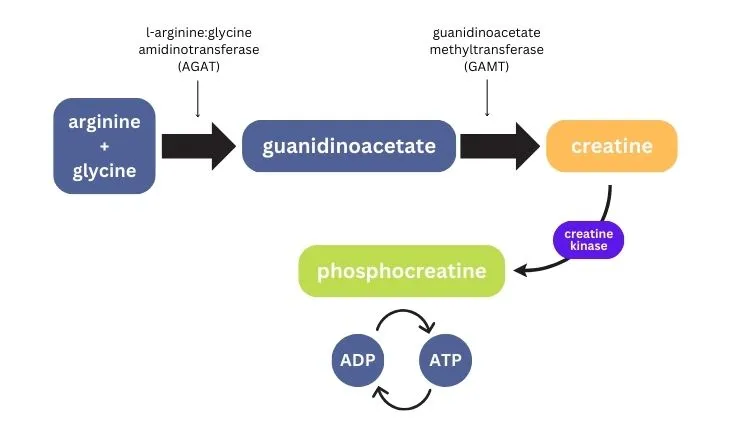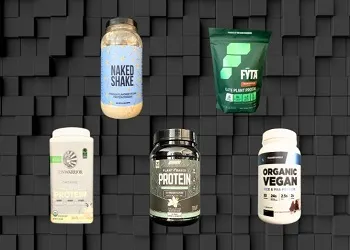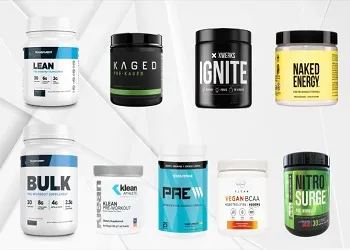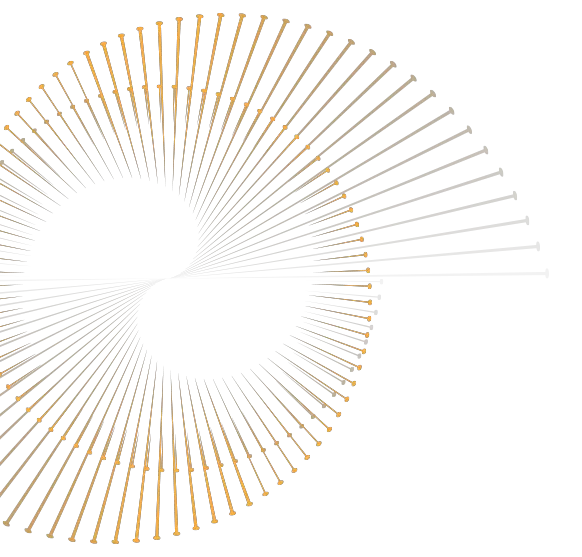Lower doses of creatine reach peak plasma concentration in about one hour, while higher doses (>10 g) can take up to 2.5 hours to reach peak plasma concentrations. Following ingestion, creatine levels remain elevated for about four hours. Creatine levels return to normal following cessation of supplementation in about four weeks.
Quick Look
- Creatine is an amino-acid derivative that plays a major role in energy production for metabolically active tissues.
- Creatine is synthesized from three amino acids: arginine, glycine, and methionine.
- The half-life of creatine is around 3 hours, but 100% of exogenously administered creatine should clear plasma within 24 hours.
- After high-dose supplementation, creatine levels should return to baseline within 30 days.
Table of Contents
What Is Creatine?
Before we get into the details of creatine absorption and elimination, let’s look at what creatine is and why it’s one of the most popular fitness supplements on the market.
Creatine is more than just a gym junkie’s best friend or the secret sauce to make you swole. It’s a naturally occurring amino acid derivative synthesized from three amino acids:
- Arginine
- Glycine
- Methionine
Creatine’s primary function is to supply energy to tissues with high energy demands, such as the brain and muscles. This is accomplished via phosphocreatine’s high-energy phosphate bonds that can immediately replenish ATP stores during energy-demanding activities.
Simply put, creatine plays a pivotal role in recycling adenosine triphosphate (ATP), the muscles’ primary energy source.

Studies suggest that creatine can improve:
- Force and power output
- Strength
- Anaerobic threshold
- Work capacity
- Muscle recovery
- Training adaptations
Some research also suggests that creatine may improve anaerobic exercise performance by increasing time to exhaustion and enhancing glycogen storage.
Key takeaway: Creatine is an amino acid derivative found in high concentrations in skeletal muscle tissue. Its primary role is to support the recycling of ATP during vigorous, high-intensity exercise.
What Do Creatine Supplements Do?
You’ve probably seen creatine all over fitness websites, but what does it actually do? Creatine plays a vital role in the body’s energy production, which offers immense benefits for muscle growth and athletic performance.
In short, creatine supplementation helps maintain a continuous supply of energy to active muscle tissues and other tissues with high energy demands through the breakdown and regeneration of ATP. This is done through phosphocreatine’s high-energy phosphate bonds that can immediately replenish adenosine triphosphate stores during energy-demanding situations.
Here’s a more specific description.
When creatine enters muscle cells, it readily combines with phosphate to form creatine phosphate (or phosphocreatine, PCr), a high-energy phosphagen stored in the ATP-CP system. The ATP-CP energy system is integral for rapid energy production during speed and power exercises, such as heavy weight lifting or boxing.
In simple terms, when muscles start to run low on energy, the enzyme creatine kinase (CK) transfers a phosphate group from phosphocreatine to ADP to produce ATP—but this can only happen if there is enough phosphocreatine present, hence why we take creatine supplements.
So, now that you understand how creatine contributes to energy production, you can start to connect the dots on how creatine enhances exercise performance:

The results:
More strength + faster recovery + better performance
Those three outcomes are the primary reason creatine is a big deal in the fitness world—it’s a game-changer for your workouts and results.
What Affects Creatine Retention in Skeletal Muscles?
The primary goal of creatine supplementation is to increase the energy supply to active muscle. That means that post-ingestion, creatine is taken up by muscle cells. However, while this is the intended goal, this doesn’t always happen to the extent we need it to.
After creatine consumption, several factors can influence how much creatine is retained in muscles.
Once creatine enters the bloodstream (after de novo synthesis in the liver and kidneys), it’s distributed to muscle tissue—about 95% of creatine stores in the body are concentrated in skeletal muscles. From there, the amount of creatine retained in skeletal muscle and the excretion rate are highly individualized and vary between people.
Some of the biggest factors influencing creatine uptake and retention include:
- How long you’ve been supplementing creatine
Creatine extension is largely affected by how much creatine is already stored in muscle tissue. When your muscles aren’t fully saturated, you’ll naturally retain more than you would after a creatine load.
If you haven’t taken creatine before or taken a break from creatine supplementation for an extended period, you’ll likely retain more.
The average person stores around 120 g of creatine without supplementation, and the body uses about 2 to 3 g daily. So, if you add 3 to 5 g through supplementation, you’ll store more creatine than you’ll use—what’s consumed over what can be stored is excreted in urine.
As such, creatine retention is highest when you start supplementing and slowly decreases as muscles become fully saturated.
- How often you take creatine
To see results with creatine, you have to be consistent with supplementation. If you’re not taking creatine regularly, creatine retention will likely be higher than if you’re supplementing daily—but this isn’t as beneficial as it sounds since you’re not achieving fully saturated creatine stores. If you want to see the benefits of creatine supplementation, you’ll want to keep your stores fully saturated and be consistent with intake.
- How you take creatine
While a minor factor, when you take creatine can affect retention. Studies show that creatine uptake is improved when levels of sodium and insulin are high—i.e., taking creatine alongside carbohydrates (or anything that raises insulin) can enhance absorption. Sodium functions as a creatine transporter, and this process is enhanced when insulin levels are high.
Individual Factors Affecting Creatine Stores
In addition to factors that affect creatine retention in skeletal muscle, several individual factors affect creatine stores and how long creatine stays in your system. These include:

Muscle Mass
This one is pretty simple—the more muscle mass you have, the more creatine your body can store. If you want to maximize creatine retention, consider putting on muscle. One study found a positive correlation between BMI and creatine, suggesting that a higher BMI equates to a higher creatine clearance rate within 24 hours. However, it’s important to note that BMI does not indicate muscle-to-fat ratios.
Activity
Exercise, especially resistance training, has two-fold benefits for creatine levels—it helps build muscle to increase the amount of creatine your body can store but also enables more efficient use and storage of creatine.
Dose
The amount of creatine you supplement significantly impacts retention levels. Studies show that short-term creatine loading (consuming 5 g, four times daily for 5-7 days) can increase intramuscular creatine stores by 20–40% and exercise performance capacity by 5–10%.
It’s also important to remember that individual variation in health status will affect how long creatine stays in your system. For example, people with hepatic (liver) impairment may retain creatine longer than people with normal liver function. Similarly, individuals with impaired renal function may find it takes longer to metabolize creatine than people with normal renal function.
Key takeaway: Creatine retention and excretion times vary based on the individual, but factors such as muscle mass, activity level, and dosage can influence retention rates. Unless a prior liver or kidney issue is present, most people excrete excess creatine within a standard time frame.
How Long Does Creatine Stay in Your System?
To understand how long a creatine supplement stays in your system, it’s important to understand its creatine metabolism and half-life. The elimination half-life of creatine is roughly 3 hours—this means that about 50% of a creatine dose will be cleared from plasma about 3 hours after creatine ingestion.
Based on this, 100% of supplemental creatine should be cleared from your system within 16.5 hours of your final dose. Simply put, there shouldn’t be any lingering traces of exogenous creatine in plasma after 24 hours.
Remember that exogenous creatine produces metabolites: phosphocreatine (67%) and creatinine (2%).
Phosphocreatine should be eliminated from plasma within 16.5 hours, while creatinine may take slightly longer; creatinine has a half-life of around 3.85 hours, meaning it will stay in your system longer than creatine. As such, the 2% of creatinine derived from creatine may stay in circulation for just over 21 hours after ingestion.
Results: In most cases, creatine and its metabolites should be out of your plasma within 24 hours post-consumption.
However, some research suggests that complete excretion could take slightly longer.
One study found that among athletes supplementing with creatine for 7 consecutive days, roughly 46% of creatine was excreted within 24 hours after discontinuing creatine supplementation. That said, some other research suggests that accumulation of creatine within muscles after prolonged supplementation at higher loading doses can take up to 30 days to reach baseline levels.
Put simply, it could take up to a month for intramuscular creatine levels to drop back to pre-supplementation levels.
How Is Creatine Eliminated from the Body?
About 1-2% of the creatine in muscle is naturally broken down into creatinine, which is then eliminated from the body through urine. The breakdown of creatine into creatinine is higher in people with more muscle mass and individuals with higher physical activity levels.

Image: Creatine synthesis and elimination pathway.
If you have high creatinine levels, it could be a sign that your body isn’t eliminating creatine properly. Under normal circumstances, creatinine is transported in the blood to the kidneys, where it’s filtered through urine. But if kidney function is compromised, creatinine levels can rise.
Creatine Supplementation Safety and Side Effects
Creatine may be one of the most widely used sports supplements, but that doesn’t mean it’s risk-free.
Some side effects of creatine intake include:
- Changes in urination (frequency, pain, foaminess, or blood)
- Muscle cramps
- Nausea or vomiting
- Fatigue
- Puffiness around the eyes
- Swelling in the feet or ankles
If you’re taking any of the following drugs or medications, consult with your healthcare provider before starting creatine supplements:
- Non-steroidal anti-inflammatory drugs (NSAIDs)
- Caffeine
- Diuretics
- Cimetidine (Tagamet)
- Drugs that affect the kidneys
- Probenecid
People with kidney disease, high blood pressure, or liver disease should avoid creatine supplementation, as should people who are pregnant or breastfeeding due to a lack of research on its safety.
Frequently Asked Questions
How long does creatine stay in your body?
How long creatine will stay in your system depends on the creatine supplement dose. Lower doses of creatine (~5g/day) have shorter retention times than higher doses (>20g/day). Creatine half-life is 3 hours, meaning a lower dose would be down to 2.5g within 3 hours, whereas a higher dose would be down to 10g within 3 hours. In most cases, exogenous creatine is eliminated through urine within 24 hours, regardless of the dose.
What happens if you stop taking creatine?
If you discontinue creatine supplements, the body will eventually return to its normal production of creatine. However, you may experience minor decreases in strength, endurance, and performance, but this may be negligible. A proper diet of creatine-rich foods can help support your body’s natural production of creatine and offset any significant side effects of stopping supplementation.
How long does creatine take to leave your system?
Following a loading phase (>20g/day) of creatine, it can take anywhere from two to four weeks for creatine levels to return to baseline values. Most research suggests that pre-supplementation levels are reached in about 30 days.
What is the creatine monohydrate half-life?
The half-life of creatine monohydrate is about 3 hours.














